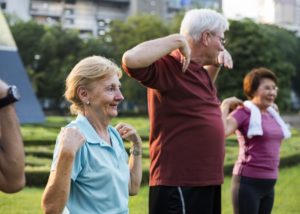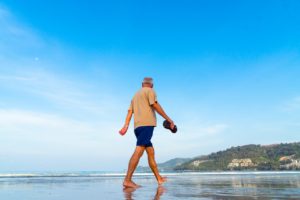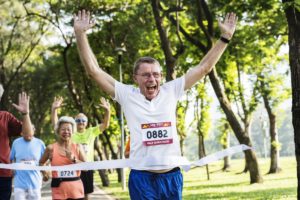 For the first time in census history the number of individuals 65 years and over exceeds the number of children under 15 years of age (Stats Canada, 2016). According to the World Health Organization (2012), by 2050 the proportion of the world’s population over 60 years of age will double from 11% to 22%. As we age, several biological, behavioral, social, and environmental risk factors decrease our mobility and increase our risk of falling (Sherrington, 2008). For example, poor balance, altered gait patterns and a decrease in muscle strength are three significant biological factors that limit an older adult’s mobility and which subsequently increases their risk of falling (Daley & Spinks, 2000). Falling can decrease an individual’s quality of life because they can lead to fractures that result in disability and mortality. In order to prevent osteoporotic fractures and maintain our quality of life as we age, it is critical health professionals assess an individual’s functional mobility, strength and fall risk.
For the first time in census history the number of individuals 65 years and over exceeds the number of children under 15 years of age (Stats Canada, 2016). According to the World Health Organization (2012), by 2050 the proportion of the world’s population over 60 years of age will double from 11% to 22%. As we age, several biological, behavioral, social, and environmental risk factors decrease our mobility and increase our risk of falling (Sherrington, 2008). For example, poor balance, altered gait patterns and a decrease in muscle strength are three significant biological factors that limit an older adult’s mobility and which subsequently increases their risk of falling (Daley & Spinks, 2000). Falling can decrease an individual’s quality of life because they can lead to fractures that result in disability and mortality. In order to prevent osteoporotic fractures and maintain our quality of life as we age, it is critical health professionals assess an individual’s functional mobility, strength and fall risk.
As we age, physiological changes in our bodies create biological risk factors that decrease our mobility. After the age of 40 our bone density begins to slowly decrease and is more accelerated in women after menopause because estrogen plays an important role in the uptake of calcium, which helps maintain our bone density (Cauley, 2013). As a result, our risk of osteopenia increases. In addition, sarcopenia, which is an age associated loss of muscle mass and strength, also begins around the age of 30. Research by Walston (2012) defines sarcopenia as a gradual loss in fast-twitch or type-2 muscle fibers as we get older. Currently, it is believed that we lose about 2-5% of muscle mass per decade. These physiological changes decrease our muscle strength and increase our risk of falling, fracture, and osteoarthritis later in life. A recent meta-analysis by Yeung et al demonstrated a significantly positive correlation between sarcopenia and the risk of falls and fractures. The causal relationship also works in the reverse in that falls and fractures in turn, results in sarcopenia due to the resulting decline in physical activity, muscle function and strength. While the biological changes that contribute to sarcopenia are in fact age-related, research indicates that obesity and physical inactivity also play important roles in its development (Walston, 2012). So, the good news is that the effects of sarcopenia can be reduced with appropriate physical activity and strength training throughout life. Thankfully, health professionals, like physiotherapists, can use effective strategies, like exercise, and functional mobility assessments to prevent falls and maintain our quality of life as we age.
 Physical activity and exercise reduce the risk of falling because it can improve or maintain our balance, muscle strength, and functional independence as we get older. According to a study by Sherrington (2008), exercise can decrease the prevalence of falls by 17% in the general population and by as much as 31% in populations at higher risk, such as, nursing home residents or those who have had a previous fall. Their data demonstrated exercise programs that have a balance component produced a 35% reduction in fall and fall-related injuries (Sherrington, 2008). Therefore, although we will all experience the effects of aging at some point in our lives, its effects can be delayed and partially overcome by exercise.
Physical activity and exercise reduce the risk of falling because it can improve or maintain our balance, muscle strength, and functional independence as we get older. According to a study by Sherrington (2008), exercise can decrease the prevalence of falls by 17% in the general population and by as much as 31% in populations at higher risk, such as, nursing home residents or those who have had a previous fall. Their data demonstrated exercise programs that have a balance component produced a 35% reduction in fall and fall-related injuries (Sherrington, 2008). Therefore, although we will all experience the effects of aging at some point in our lives, its effects can be delayed and partially overcome by exercise.
In 2011 the Canadian Society of Exercise Professionals (CSEP) released their physical activity guidelines for individuals 65-years of age and older. To achieve health benefits and improve functional mobility, older adults should accumulate a minimum of 150 minutes of moderate-to vigorous exercise per week. In addition, exercise sessions or physical activities should be performed in bouts of at least 10 minutes or more and should incorporate both balance and strength training components. Some examples of moderate-intensity activities are brisk walking or cycling that increase your respiration. Examples of vigorous-intensity activities include things like cross-country skiing and swimming or any activity that results in the feeling of ‘out of breath’ (CSEP Guidelines, 2011). Lifting weights or resistance training is an important component of maintaining or gaining muscle strength and reducing its decline.
 The take home message is clear: the benefits of balance and strength training and continued physical activity is the best medicine to combat age related decline in all markers of health. Should you have any concerns before embarking on an exercise program, speak with your trusted health professional. Physiotherapists have the ability to assess your strength, balance and fall risk. And if you live in Edmonton, do not allow our weather to discourage you from exercise. Whether you prefer to exercise indoors or out, the point is to do so consistently, in all our seasons of life. And be sure to have fun doing so!
The take home message is clear: the benefits of balance and strength training and continued physical activity is the best medicine to combat age related decline in all markers of health. Should you have any concerns before embarking on an exercise program, speak with your trusted health professional. Physiotherapists have the ability to assess your strength, balance and fall risk. And if you live in Edmonton, do not allow our weather to discourage you from exercise. Whether you prefer to exercise indoors or out, the point is to do so consistently, in all our seasons of life. And be sure to have fun doing so!
References
Cauley, A. J. (2013). Public health impact of Osteoporosis. Journal of Gerontology, 68(10), 1243-1251.
CSEP Guidelines. (2011). Retrieved from http://www.csep.ca/CMFiles/Guidelines/CSEP_PAGuidelines_older-adults_en.pdf
Daley, M. J. and Spinks, W. L. (2000). Exercise, mobility and aging. Journal of Sports Medicine, 29(1), 1-12.
Sherrington, C. et al. (2008). Effective exercise for prevention of falls: A systematic review and meta-analysis. American Journal of Geriatrics Society, 56(12), 2234-2243.
Stats Canada. (2016). Retrieved from https://www.statcan.gc.ca/eng/sc/video/2016census_agesex
Walston, D. J. (2014). Sarcopenia in older adults. Current Opinion in Rheumatology, 24(16). 623-527.
World Health Organization. (2012). Retrieved from https://www.who.int/world-health-day/2012/toolkit/background/en/
Yeung et al. (2019). Sarcopenia and its association with falls and fractures in older adults: A systematic review and meta-analysis. Journal of Cachexia, Sarcopenia and Muscle, https://doi.org/10.1002/jcsm.12411
Submitted by Trevor Day (Kinesiology Student) and Albert Chan
